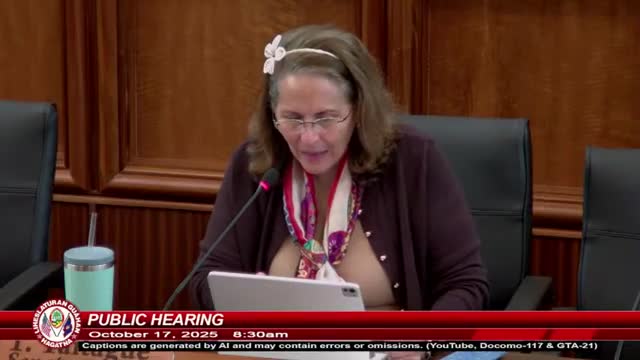Committee hears bill directing DRT to issue RFP for robotic process automation pilot
October 17, 2025 | Legislature 2025, Guam
This article was created by AI summarizing key points discussed. AI makes mistakes, so for full details and context, please refer to the video of the full meeting. Please report any errors so we can fix them. Report an error »

Hagatna, Guam — On Oct. 17 the Guam Legislature committee heard Bill 178-38, introduced by Senator Tina Rose Munoz Barnes, which would require the Department of Revenue and Taxation to issue a request for proposal (RFP) for a pilot robotic process automation (RPA) program to automate repetitive digital tasks in DRT operations.
Senator Tina Rose Munoz Barnes said the bill would allow government employees to “focus on higher value judgment based work” by automating routine processes and hoped the measure would shorten lines and processing times for the public. “This program isn’t new, madam chair. Governments around the world have implemented RPAs to better service their communities,” Barnes said.
The Department of Administration submitted written testimony noting the current DRT system may have capacity to implement RPA but that a walk-through and first-hand observation of branch processes are needed to determine the appropriate type of automation. DOA said a walkthrough/observation was tentatively scheduled for Oct. 21, 2025. DRT provided written comment that it cannot provide a vendor quotation without a defined scope of work; DOA also warned some RPA configurations are event-triggered while others run automatically.
Committee members voiced routine concerns for technology bills: how implementation would affect staffing, whether automation would replace employees, what protections or compensation would be needed for affected workers, and how quality assurance and monitoring would be provided. Chairwoman Atelo Taittigui urged committee members and agency staff to raise technical questions at the planned walkthrough and in the markup stage.
Why it matters: Senators said the bill aims to reduce human error and speed public-facing transactions at a government agency that has reported limited staffing. Supporters described the measure as a pilot to explore automation and scale successful practices to other agencies. Witnesses cautioned RPA is evolving rapidly and may be augmented by artificial intelligence; agencies warned that scope-of-work details and monitoring plans are required before cost and procurement can be estimated.
Process and next steps: The bill was duly heard; no vote was taken. The committee invited written testimony for five working days and signaled that a markup following agency walkthroughs would address implementation, scope, monitoring, and workforce protections.
Senator Tina Rose Munoz Barnes said the bill would allow government employees to “focus on higher value judgment based work” by automating routine processes and hoped the measure would shorten lines and processing times for the public. “This program isn’t new, madam chair. Governments around the world have implemented RPAs to better service their communities,” Barnes said.
The Department of Administration submitted written testimony noting the current DRT system may have capacity to implement RPA but that a walk-through and first-hand observation of branch processes are needed to determine the appropriate type of automation. DOA said a walkthrough/observation was tentatively scheduled for Oct. 21, 2025. DRT provided written comment that it cannot provide a vendor quotation without a defined scope of work; DOA also warned some RPA configurations are event-triggered while others run automatically.
Committee members voiced routine concerns for technology bills: how implementation would affect staffing, whether automation would replace employees, what protections or compensation would be needed for affected workers, and how quality assurance and monitoring would be provided. Chairwoman Atelo Taittigui urged committee members and agency staff to raise technical questions at the planned walkthrough and in the markup stage.
Why it matters: Senators said the bill aims to reduce human error and speed public-facing transactions at a government agency that has reported limited staffing. Supporters described the measure as a pilot to explore automation and scale successful practices to other agencies. Witnesses cautioned RPA is evolving rapidly and may be augmented by artificial intelligence; agencies warned that scope-of-work details and monitoring plans are required before cost and procurement can be estimated.
Process and next steps: The bill was duly heard; no vote was taken. The committee invited written testimony for five working days and signaled that a markup following agency walkthroughs would address implementation, scope, monitoring, and workforce protections.
View full meeting
This article is based on a recent meeting—watch the full video and explore the complete transcript for deeper insights into the discussion.
View full meeting